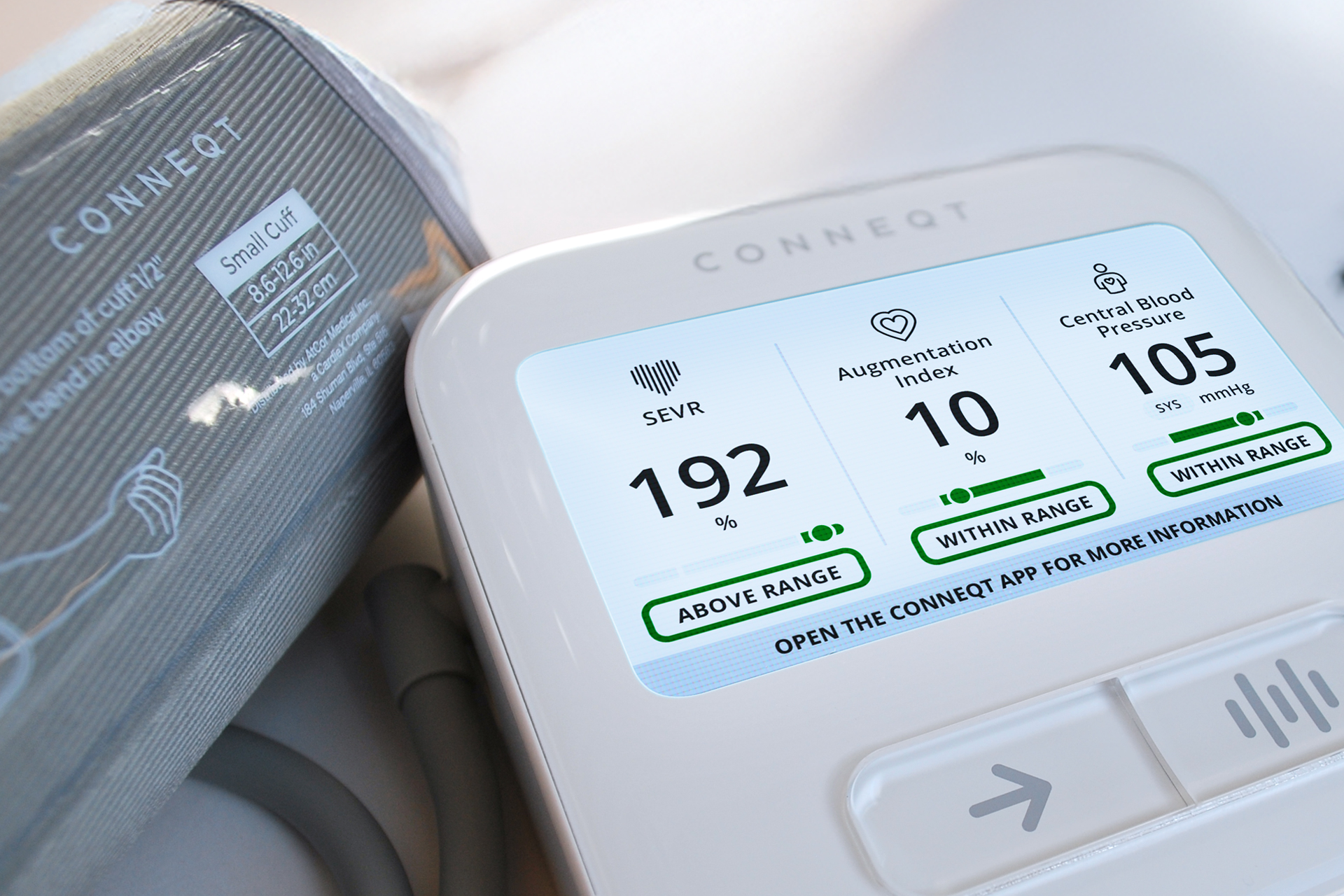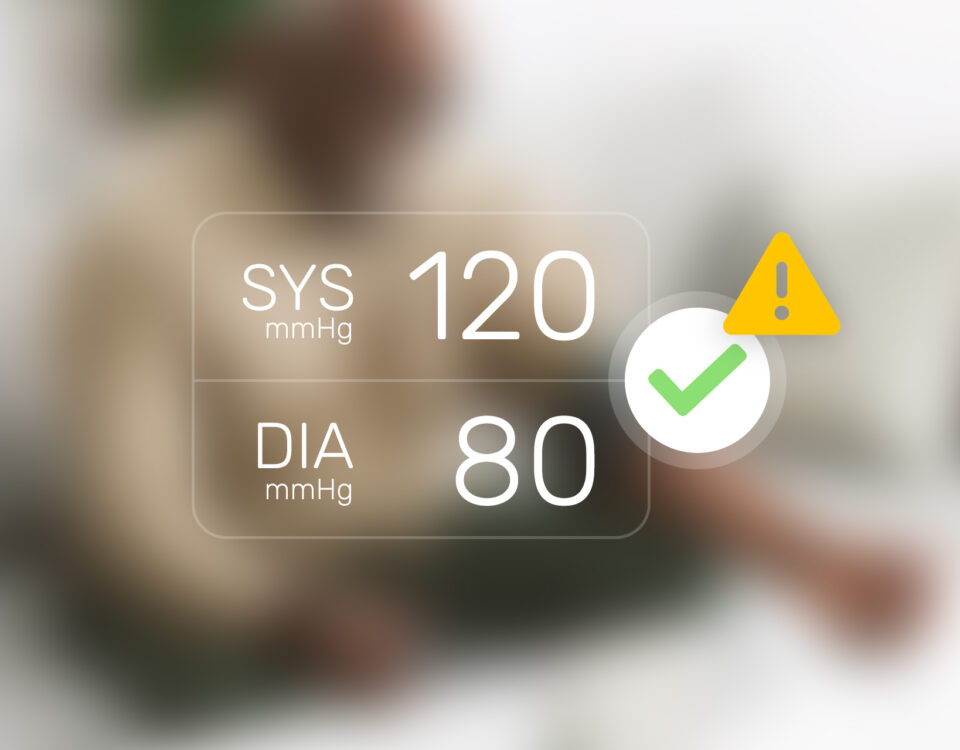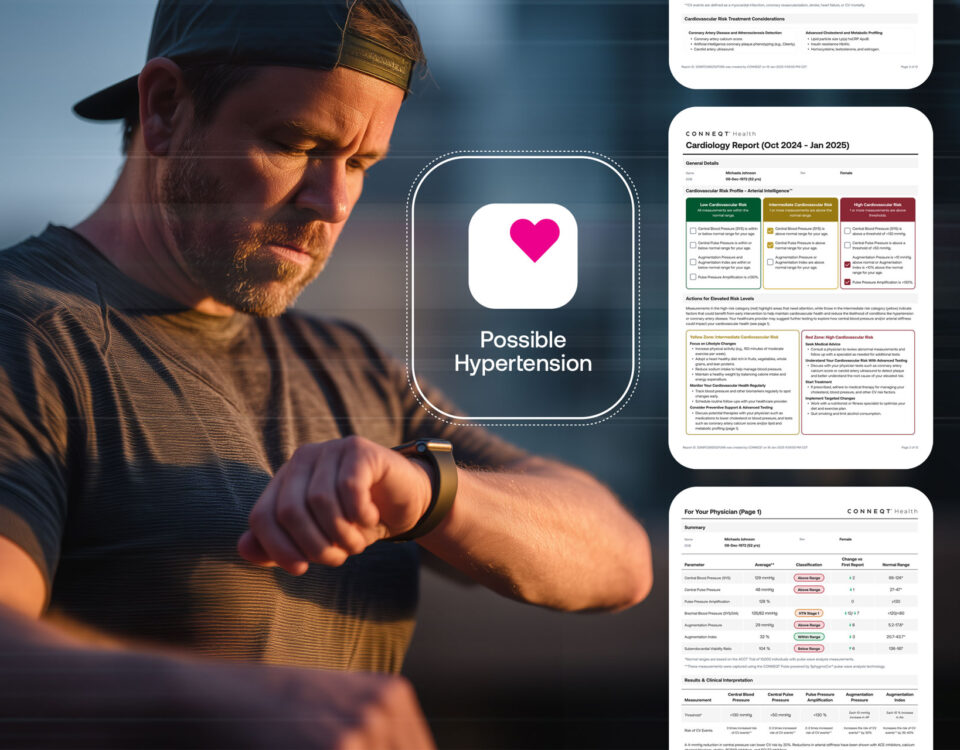A Smarter Way to See Risk Coming
Heart attacks and strokes don’t always come with a warning sign. In fact, according to the CDC, about 1 in 5 heart attacks are “silent,” meaning they cause no noticeable symptoms but still damage the heart and increase future risk. And many of these events happen in people who had “normal” blood pressure readings when checked with a traditional cuff.
That’s because most home monitors only measure brachial blood pressure, the pressure in your arm. But that’s just one piece of the puzzle.
CONNEQT Pulse goes deeper.
It’s the first at-home product that tracks artery-level heart health metrics, giving you a clearer view of cardiovascular risk before symptoms appear. Powered by SphygmoCor technology, the same technology used in hospitals and research settings, the Pulse measures key indicators related to the early development of heart attack, stroke, plaque buildup, and even arterial calcification.
Whether you’re focused on prevention or tracking long-term trends, it helps you go beyond traditional 120/80 readings.
What Traditional Cuffs Miss
Traditional cuffs only tell you how much pressure is in your arm. But what really matters is what’s happening deeper, especially in the arteries closest to your heart and brain.
Serious cardiovascular issues often begin with silent changes like:
- Arteries becoming stiff or less elastic
- Higher pressure on central arteries (not reflected in arm readings)
- A mismatch between how hard your heart works and how much oxygen it gets
- Shifts in how blood moves through your arteries that signal early aging or plaque
These warning signs usually appear long before any symptoms do.
CONNEQT Pulse captures these early shifts by analyzing the shape, strength, and timing of blood pressure waves. The result? You get insights that a traditional cuff simply can’t deliver, and data you can act on.
How the Pulse Measures Risk from the Inside Out
When you take a reading with CONNEQT Pulse, it doesn’t just record your top and bottom numbers. The process starts with a traditional brachial blood pressure measurement, then goes deeper by capturing the pulse wave generated by your heartbeat.
Using SphygmoCor® technology, the Pulse analyzes the shape, strength, and timing of this wave to assess how blood moves through your arteries. It models central blood pressure and calculates a set of artery-level indicators that reveal how well your cardiovascular system is functioning, how much strain your heart is under, and whether silent changes may be underway.
These aren’t just numbers. They’re signals: Are your arteries elastic or stiff? Is pressure spiking where it shouldn’t? Is your heart getting the oxygen it needs?
This is what sets Pulse apart from traditional monitors. It’s not just taking a reading. It’s providing a clearer view of your cardiovascular health using the same science trusted in hospitals and research institutions.
The Metrics That Matter: What They Reveal About Risk
Heart Attack Risk
- Subendocardial Viability Ratio (SEVR) reflects how well your heart muscle is getting oxygen. Think of it like a fuel-efficiency score for your heart. If SEVR is low, your heart may be under too much strain.
- Central Blood Pressure CBP) shows the pressure your heart and brain are actually experiencing. High central pressure is a better predictor of heart attack than arm pressure alone.
Stroke Risk
- Central Pulse Pressure (CPP) is the gap between your top and bottom numbers. A wide gap, indicated by a higher number, especially when paired with arterial stiffness, can increase your risk of stroke.
- Elevated central pressure also puts added stress on the brain’s blood vessels.
Plaque Buildup Risk
- Augmentation Index (AIx) and Pulse Pressure Amplification (PPA) indicate how much blood flow is bouncing back against artery walls. Increased wave reflection is linked to arterial stiffness and early plaque formation.
Calcification Risk
You can’t manage what you don’t measure.
- Arterial Stiffness metrics, including AIx and Pulse Wave Velocity (PWV), track how flexible or rigid your arteries are. While the Pulse doesn’t directly measure calcium, higher stiffness is often a sign of vascular aging and early calcification.
Why Numbers Matter
Traditional checkups offer one-time snapshots with vague labels like “elevated” or “borderline.” But cardiovascular risk isn’t binary. It exists on a spectrum. The earlier you know where you stand, the better your options.
Pulse turns vague risk into quantifiable metrics:
- Track trends over time to see what’s improving or getting worse
- Understand where you fall on each health metric with color-coded zones
- Monitor the impact of lifestyle changes, medications, or stress
You’ll see these insights come to life in your personalized reports. CONNEQT Pulse delivers data in easy-to-understand, color-coded reports that highlight trends, flag areas to watch, and show how your cardiovascular metrics change over time.
Whether you check in weekly with an On-Demand Assessment or monthly with your Cardiology Report, these tools help translate your numbers into action.
Data-backed clarity helps you act sooner, not later.
“It works like advertised… Still the best device/app combo I’ve seen.”
— Joshua M., CONNEQT Pulse User
From Insight to Action
Knowing your risk is just the first step. The real power of CONNEQT Pulse is what you can do with that knowledge.
The Pulse works hand-in-hand with the CONNEQT Health app to help you:
- Make targeted changes in sleep, nutrition, movement, and stress
- Set goals and track improvement across key metrics
- Share results with your physician to inform care decisions
You’re not waiting for something to go wrong. You’re building a smarter, more proactive relationship with your health.
Who Is CONNEQT Pulse For?
CONNEQT Pulse is designed for anyone who wants to take control of their cardiovascular future. It is especially valuable for people who:
- Have a family history of heart disease or stroke
- Are managing high blood pressure or metabolic health
- Are 40+ and want to track early signs of vascular aging
- Are focused on performance, longevity, or biohacking
- Want to protect brain health by maintaining healthy blood flow
If you’ve ever been told “everything looks fine” but still have questions, CONNEQT Pulse can help you find answers.
“This device is going to be a game-changer… it’s like the check engine light going on.”
— Dr. Michael Twyman, MD, board-certified cardiologist and founder of Apollo Cardiology
Risk You Can See. Change You Can Make.
The CONNEQT Pulse empowers you to see what most monitors can’t. It moves beyond traditional blood pressure to show how your heart and arteries are truly performing, giving you the data, insight, and confidence to take control of your cardiovascular health.
For those looking to prevent disease, optimize performance, or stay ahead of family risk, that clarity can lead to better conversations, earlier decisions, and more confident care.
Because understanding your risk is the first step in changing it.
CONNEQT Pulse is not intended to diagnose or treat any medical condition. Always consult your physician when making decisions about your health.






